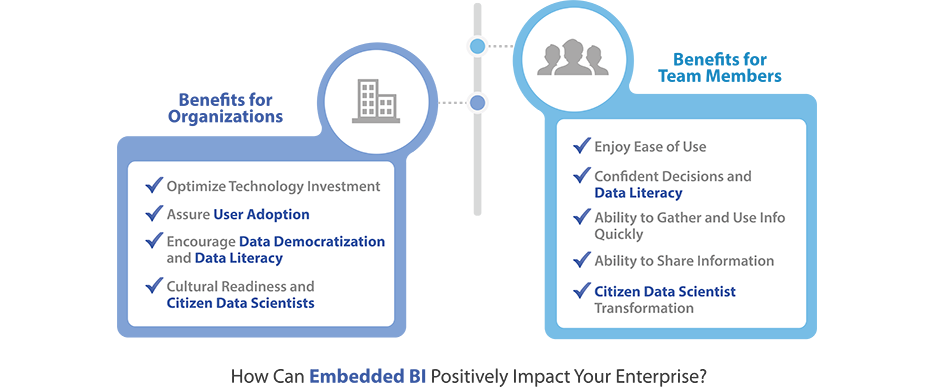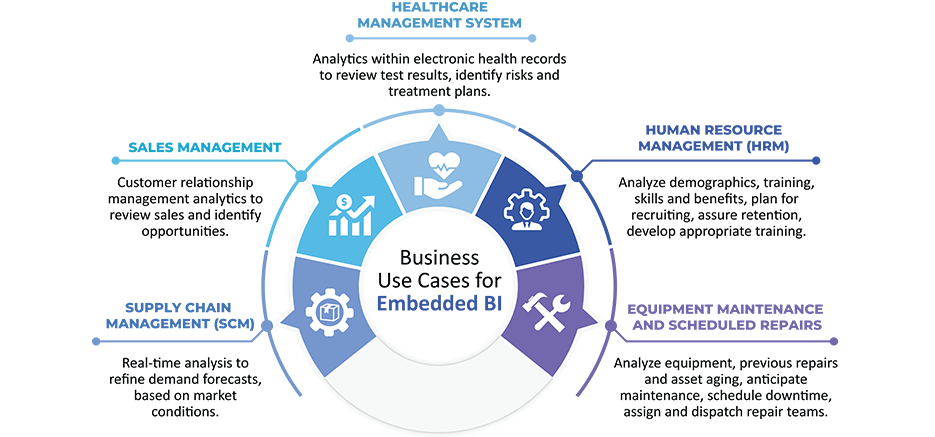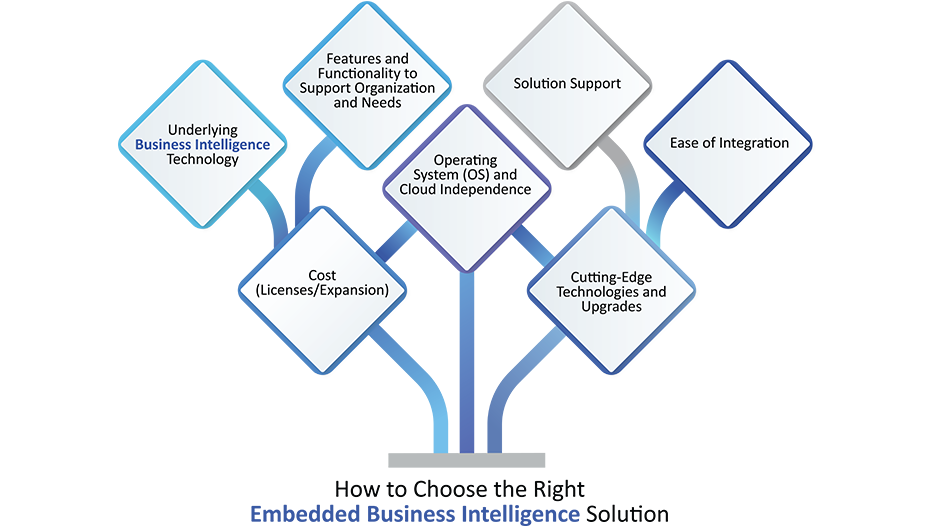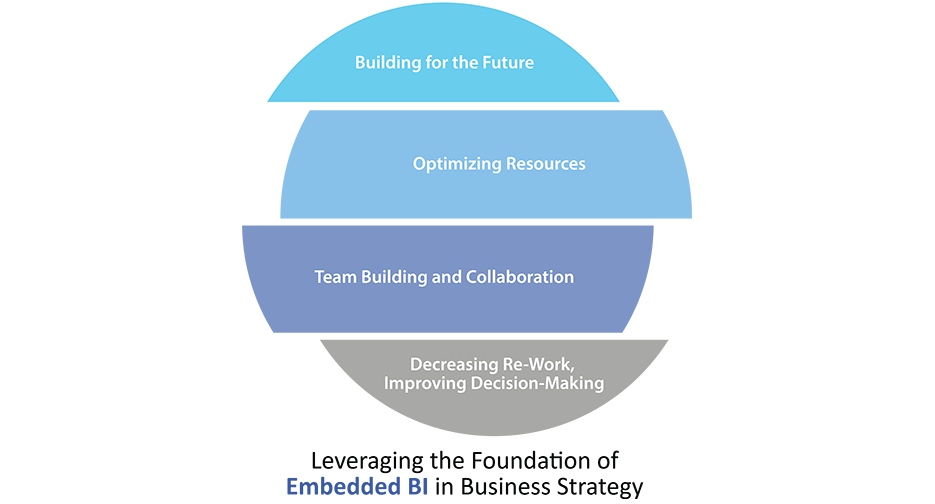What is Embedded BI How Can It Support Your Enterprise and Improve Business Results?
Introduction
When a business is considering the prospect of adding business intelligence and analytics to its technology landscape, it must undertake a comprehensive review of its requirements, its current technology capabilities and the prospective vendors and solutions in the market. The exercise must include a strategic and operational view of where the enterprise is going, the expected growth, its business user and organizational readiness for change, and many other factors.
No matter the industry, business function or size of an enterprise, there are two primary truths in all organizations today. First, your business and your team are more mobile than ever, and secondly, in order for your business to remain competitive, you must do more with less. You must leverage the knowledge and experience within your business team and optimize that knowledge and those resources to quickly and efficiently complete tasks and make fact-based decisions in order to reduce re-work.
In this article, we will discuss the advent, accessibility and advantages of Embedded Business Intelligence (BI), how Embedded BI can help you achieve your goals and provide your users with tools they will want to adopt, and when and where these tools can be used to achieve results.
What is Embedded Business Intelligence?
To answer the question, ‘what is embedded BI,’ let’s start with the definition of embedded analytics and then provide some context. The technology research firm, Gartner, Defines Embedded Analytics as, ‘…a digital workplace capability where data analysis occurs within a user’s natural workflow, without the need to toggle to another application.’
Embedded Analytics, also known as Embedded BI is so named because it integrates analytics capabilities and techniques within a software solution, application, technology platform or website. Rather than providing users with separate BI tools that require migration of data to complete analytical tasks, the Embedded Business Intelligence Solution enables users to easily gather, analyze, visualize and share data, reports and information from within a familiar enterprise application they use in their workflow every day.
Business users can use data analysis to make fact-based decisions quickly and confidently and spot trends, patterns, issues and opportunities for purchasing, inventory planning, sales and marketing, production, supplier issues, shipping, financial investment, production downtime and many other enterprise tasks and activities.
While the Gartner definition of Embedded BI suggests that embedded analytics are often, ‘…narrowly deployed across specific processes such as marketing campaign optimization…and financial budgeting,’ today’s businesses are actively considering the use of these tools across the enterprise to improve results, increase user adoption of analytics and ensure efficiency, productivity and competitive advantage.
According to recent studies, Embedded BI is growing in popularity, primarily because businesses find it increases data democratization, data literacy, user adoption and, most of all, data-driven decision-making.
- 73% of users and 92% of surveyed industry experts state that embedded BI is critical or very important.
- User adoption of embedded BI was reported to be 57% primarily because of integration features such as single sign-on and REST API.
- The primary targets for embedded BI include ERP apps and web portals, with users reporting strong interest in analytical features like data visualization.
Why Embedded BI vs. Stand-Alone BI?
Embedded BI is designed to support the same analytical tasks as stand-alone BI. Some stand-alone BI platforms may offer embedded BI capabilities. Both solutions help users to gather, analyze, visualize and report on data in order to help the enterprise and its users make confident decisions. But, stand-alone BI tools do not directly embed analytical tools within enterprise apps. As its name implies, embedded analytics, puts BI and analytics features and analytical techniques within familiar/popular business applications in a single sign-on environment so that business users can easily access and leverage analytics from within these enterprise apps and software products to analyze, report on and share data.
Here are just a few of the advantages embedded BI provides as compared to traditional BI tools and analytics solutions:
- Users can leverage familiar/popular solutions and work within these day-to-day use apps and software products to perform analytics.
- Single sign-on tools are easy and fast to use and will increase productivity and BI adoption.
Now that you have a clear understanding of Embedded BI, it is time to consider how these tools might work for your own business. It is important to engage your IT team, your business users and your managers to brainstorm and create business use cases for the divisions and departments you wish to engage with embedded analytics. Look at the applications, software products and platforms you want to include and review the tasks and workflow you wish to improve by incorporating analytics.
How Can Embedded BI Positively Impact Your Enterprise?
Before we review Embedded BI software benefits for your business, it is important to state that these advantages presume your enterprise has taken the time to review the prospective solutions and to choose the one that will best suit your technology landscape, the solutions you wish to integrate, your user workflow and user training issues, etc. In the following sections, we will discuss the process of choosing a solution and the Embedded BI Software Features you will want. Here, we will discuss the benefits of embedded BI for business users and the competitive advantages of embedded analytics for the organization. By choosing the RIGHT embedded BI solution, your organization can optimize resources, improve time-to-market, make confident decisions and gain a true understanding of results, issues, and opportunities.
Benefits for Organizations
Optimize Technology Investment – Among the numerous advantages of embedded systems is the availability of crucial features within software, apps and platforms that are already in use in your organization. This integration ensures improved return on investment (ROI) and lower total cost of ownership (TCO) for both the existing apps and platforms and for the new business intelligence solution, and optimizes the uses of these tools by making them easier and faster to employ and achieving swift results.
Assure User Adoption – Embedded BI for organizations is a wise choice, as it will enhance and enable user adoption. Your team has a workflow, tasks and activities and is probably on a tight schedule to complete tasks and achieve goals. They will NOT adopt solutions that are difficult to understand and use, or solutions that require them to move data from one place to another to perform analysis. If you want to encourage a chance within the organization and initiate data democratization, enable data literacy and ensure that your team will use new technology and tools, you must make them easy to understand and employ.
Encourage Data Democratization and Data Literacy – Your team has professional experience and career knowledge. But they are probably not data scientists or business analysts. If you want them to understand and use analytics, and to gain a deeper insight into how analytics can help them do their job, you must provide tools that engage them and allow them to expand their skills and training to include the use of analytics in presentations and staff discussions. Data literate team members are less likely to depend on opinion or guesswork to draw conclusions.
Cultural Readiness and Citizen Data Scientists – In a competitive hiring environment, you want to grow the skills of your team and retain those skills to advance your objectives and ensure competitive advantage. A well-trained team – one that understands data and can interpret that data to use in crucial decisions – is comprised of team members who can and will advance in your organization to manage goals and to use data and facts to achieve results quickly and efficiently. By transitioning business users with average technology and analytical skills to Citizen Data Scientists you can encourage your team to work with IT professionals and data scientists to refine and optimize data, to share analytics and use those analytics to make recommendations, solve problems and find and capitalize on opportunities. The data is there! Your team just has to understand it to become the asset you know they can be.
Benefits for Team Members

Enjoy Ease of Use – Selecting the right Embedded BI augmented analytics solution enables your business users with easy-to-use features and solutions so that they can quickly gather information, ask questions using natural language and receive clear, concise results with suggestions for visualization techniques and the ability to share and collaborate with other users. The benefits of embedded analytics assure that users can quickly adopt the analytics features and make them pat of their every day tasks. Single sign-on allows users to use familiar applications to gain insight into data without worry about extensive training or navigating silo applications and migrating data.
Confident Decisions and Data Literacy – The advantages of embedded systems are numerous, but perhaps one of the most important advantages for users is improved data literacy. All of your team members want to be productive and make the right decisions quickly, so they can move on to the next task but most of your team members probably lack analytics skills and data literacy. Whether they are curious about learning analytics or resistant to the idea, if they can easily gather and analyze data to improve their own workflow and make confident decisions, they are likely to give analytics a try. And as the team embraces and uses these tools, data literacy will improve and the team can more easily collaborate, using data wisely to make recommendations for change, optimize opportunities and resolve issues.
Ability to Gather and Use Info Quickly – Your team is probably much like the teams in other organizations: they have a lot to do in a very short period of time. If they don’t have the right information, or if the data they have is incomplete or difficult to understand, they will make mistakes (that’s understandable) and they will have to re-work the solution. That costs them time and can be frustrating, and it can also make them question their workflow and process.
Ability to Share Information – Every business users must work with other team members to accomplish tasks and make decisions. Providing access to analytics via embedded BI tools allows business users to gather and analyze AND share and collaborate with other users. This collaborative process ensures that all team members have the ability to weigh in on data, make suggestions, create reports and prepare presentations and recommendations for management and for team review and approval.
Citizen Data Scientist Transformation – Your team members provide value to the organization with career knowledge, experience and unique skills. When you provide the right embedded BI solution for business users, you encourage data democratization, improve data literacy and advance your team skills and comfort level with analytics, thereby enabling a transformation to a Citizen Data Scientist role. Power users and those with an interest in analytics will emerge as team leaders, creating reports and formats that can be used by others in the organization, and working with business analysts and data scientists to refine analytics for strategic purposes. These advanced skills will benefit the business user by providing career opportunities and will keep team members engaged in the organization and support team member retention and advancement.
When we consider the many uses of embedded BI for the enterprise and for business users, we can easily see how this approach will benefit the business and the team.

- Supply Chain Management (SCM) – Users can perform real-time analysis to refine demand forecasts, based on market conditions.
- Sales Management – Sales teams and sales managers can engage analytics within customer relationship management (CRM) systems to review sales results and identify opportunities based on customer buying behavior and patterns.
- Healthcare Management Systems – Providers can utilize information contained within electronic health records (EHR), to review test results and identify risks and treatment plans.
- Human Resource Management (HRM) – The organization can analyze demographics, training, skills and benefits to plan for recruiting, assure retention, develop appropriate training, etc.
- Equipment Maintenance and Scheduled Repairs – Business users can analyze equipment, previous repairs and asset aging, to anticipate periodic maintenance, schedule downtime, assign and dispatch repair teams, etc.
Now that we have discussed the benefits and advantages of embedded BI for the organization and for business users, it is time to take a look at the solution market and understand the primary considerations for features, support and other aspects of Solution Selection in order to ensure that the embedded analytics solution you choose will meet your requirements and can expand and grow with your organization.
How to Choose the Right Embedded Business Intelligence Solution

Underlying Business Intelligence Technology – To select the best embedded analytics tools, be sure you look at the foundational analytics solution and techniques. First and foremost, the underlying BI technology stack in your chosen Embedded BI platform should provide self-serve features, both traditional and modern business intelligence, augmented analytics functionality, and mobile BI and it should support the transition from business users to Citizen Data Scientists – all within an embedded BI environment that provides single sign-on access for enterprise apps. Users should not be required to have advanced analytics knowledge, data gathering skills, data science skills, etc. An embedded BI tool that requires users to be trained in analytics will not help you achieve user adoption, OR help your users become more data literate. In order to meet your requirements, the solution must be a) embedded and b) designed for business users.
Features and Functionality to Support Organization and Needs – Not all BI tools and Embedded BI solutions are created equal. The best embedded BI tool for your business will be the one that aligns with your detailed set of requirements. Understanding the features and functionality of each prospective solution will also allow you to compare what you KNOW you need to what you didn’t realize you needed and plan for expansion or leverage features that can be useful to your team.
Solution Support – When you are looking for the best embedded BI tool, do not ignore the accessibility and availability of support. While you will want a solution that is easy for your users, and you may not anticipate the need for attentive support, any software deployment and user adoption initiative will require some initial support to help your organization and users become comfortable and, if necessary, to provide support for deployment, etc.
Ease of Integration – Your embedded analytics software evaluation should include an assessment of the integration process. Does the embedded BI vendor require custom integration and workflow processes to establish and support integration within your apps? Ease of integration is key to the value of embedded analytics tools and BI software. Application Programming Interface (API) libraries play a crucial role in integration. The APIs that support embedded analytics tools must cover major aspects such as Single Sign-On (SSO), Support to embed BI content, User Management and Administration, Data Transformation and Cleansing, Filters, and many other important aspects of integration.
Operating System (OS) and Cloud Independence – The best embedded business analytics software must support your technology landscape, and the apps, software products, portals, platforms and websites within your organization. In order to avoid extensive and expensive customization, the solution you select must be OS and cloud agnostic. This independence allows you to incorporate and integrate embedded BI tools within all relevant systems and solutions.
Cost (Licenses/Expansion) – Adding a software solution to your technology environment can be a very expensive proposition. In order to achieve your return on investment (ROI) and total cost of ownership (TCO) goals, you will want to avoid costly customization and select a solution that is affordable, and flexible enough to meet your requirements. The baseline cost of the solution should support initial deployment and be affordable enough to add users and locations and to integrate with other apps and software products as you roll-out your strategy.
Cutting-Edge Technologies and Upgrades – There are many simple solutions out there that provide a skeleton for integration and product upgrade. But if you wish to ensure a foundation for future growth, you will want to choose a comprehensive solution that is easily integrated with your enterprise apps and a vendor that understands and uses cutting edge technology and has a roadmap to upgrade its embedded BI product as new technology and techniques become relevant to client and market needs. Can the prospective vendor support single and multi-tenant models and BI object templates with access to embedded BI objects from within the application? Does the vendor support comprehensive user access rights, configuration and administration tasks? Does the solution support the appropriate frameworks and technology for environments and platforms like ASP.NET, .NET, PHP, MVC, .NET Core, Vue, Angular, React, Java, and for web and mobile apps, web services, web applications, etc.? Does the Embedded BI solution include foundational programming and cutting-edge technologies like low-code, no-code (LCNC) and artificial intelligence (AI)?
The information provided in this section will give you an idea of the primary considerations for solution selection. You will also want to understand vendor stability, their team resources, the sustained skills and experience the vendor assures, and their roadmap for the future of their product(s).
Leveraging the Foundation of Embedded BI in Business Strategy

Choosing and deploying Embedded BI within your organization is a wise way to bet on your future. By offering your users simple access to sophisticated tools from within the familiar confines of your enterprise apps, you can simplify the democratization of data, improve data literacy and user adoption of analytics and improve business results and market competitive positioning.
Building for the Future – Investing in embedded BI will help you plan for the future, not only by giving users appropriate technology to add to their workflow, but by embedded analytics within that workflow and encouraging users to make data- driven decisions that will support future growth and improve time-to-market and team productivity. No matter the market in which you compete, it isn’t likely to become more forgiving in the coming years. Competition is strong and the market moves fast today. By leveraging embedded analytics, you can make the most of all of your assets and resources and confidently plan for the future of your organization.
Optimizing Resources – Most businesses cannot afford to hire additional staff…even if they NEED additional staff. To optimize the resources you have, you must work smarter and provide information and data that will ensure the right decision is made the first time, so there is no re-work or confusion. Using an enterprise system in a single sign-on environment where you can easily access analytics, can help you optimize your limited human resources and knowledge. When you consider resource optimization, you should also consider your data as a resource. Your business has a lot of data, hidden in and among your software products, apps and legacy systems, websites, platforms and data repositories. That data can and should be a resource to your organization but, without the right analytics, you cannot make the most of the data to gain insight into your challenges, find the opportunities and understand the root cause of problems
Team Building and Collaboration – If your business provides embedded BI and self-serve, easy-access analytical tools to its business users, it can encourage collaboration and allow users to gather data, create reports and presentations and share that data for comment and editing, so the team can work more quickly and efficiently and share ideas to get to the right answer.
Decreasing Re-Work, Improving Decision-Making – Reduce re-work, streamline data gathering and quickly see and understand results to achieve confident decision that are based on facts rather than opinion and guess-work.
This brief overview will give you a better understanding of the results your business can achieve by deploying embedded BI.
Embedded BI Tools Can Also Benefit ISVs
Before we complete this strategic summary, it may be valuable to briefly mention the use of embedded analytics in the realm of Independent Software Vendors (ISVs). Businesses in this sector are in a unique position and must consider their strategic growth and offerings in a different way, because the products and services they provide are customer-facing and the apps and software products they produce must grow and change with their end-user customer to achieve market share and improve customer satisfaction. So, the ISV business has a different perspective than the business that is focused on analytics for its team members and end-users within the enterprise.
When a software vendor or ISV wishes to add features and functionality to its product, it must either a) develop requirements, plan for a product development lifecycle, engage skills and resources and spend the time and money to complete the project or b) Partner With A Vendor Whose Products Already Meet Its Defined Requirements and can add value for its customers.
An ISV can consider embedded BI features to expand its reach, offer new and value-added features for customers and improve its market share. Its clients in the business-to-consumer (B2C) or business-to-business (B2B) market can benefit from analytics by leveraging Self-Serve, Easy-To-Use Analytics in any type of industry or consumer application from retail, media and travel to healthcare, government, research, infrastructure, software product development, etc.
By engaging an embedded BI vendor, the ISV can ensure appropriate return on investment (ROI) and total cost of ownership (TCO) and quickly and dependably offer new features and products to its customers.
In this article, we have defined embedded business intelligence and discussed the benefits and advantages of this type of analytics approach for businesses and users, as well as the operational and strategic impact and the importance of selecting the right vendor and embedded analytics product.
Contact Us to find out how Embedded BI can support your needs. Our Business Intelligence And Augmented Analytics solution can help your business achieve objectives. Read this free White Paper to discover the potential of embedded analytics, ‘Making The Case For Embedded BI.’ Explore our seamless Analytics Solution Technology.



